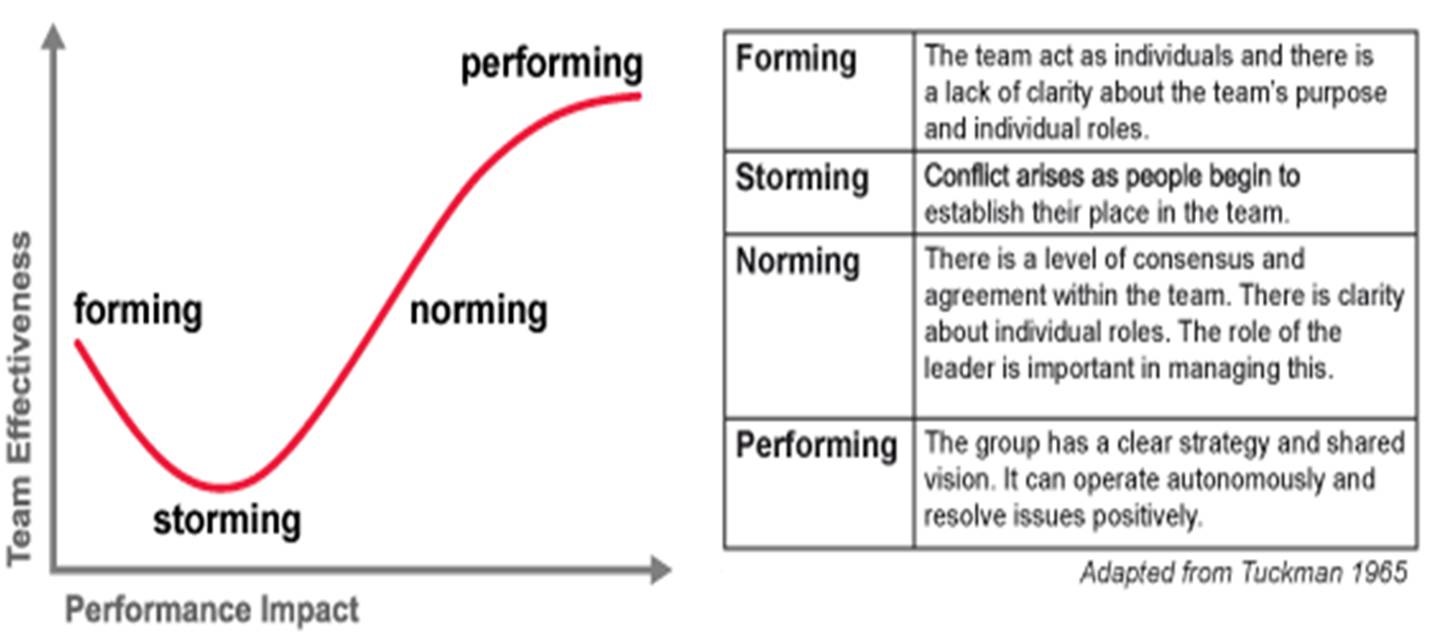If you’re reading this you probably have good understanding of agile teams characteristics.
So you know that agile teams are not just a group of individuals working each one alone, on their individual goals or within their area of expertise.
And that Agile team members share common goals, work together, and support each other in achieving their commitments, in a all the team succeed or all the team fail spirit.
Finally, Agile teams are self-organized and their day to day activity involve increased communication and collaboration.
But you might be wondering what make agile teams reach top performance and effectiveness. Interested to know ?

In 1965, Bruce Tuckman was the first to propose a team development model.
In his model, a team need to go through four stages in order to reach effectiveness and performance.
At the start, the team is formed, members agree on the goals and challenges, they tend to behave individually, this the first stage, called forming.
A bit later, conflicts will arise as each individual start establishing his position in the group, this is the second stage, it’s called storming.
In the third stage, called norming, clarity for each individual role and consensus are established. The team’s performance and effectiveness improve.
When group norms and roles are established, group members are autonomous and are able to handle the decision-making process without supervision, focusing on achieving common goals, the team reach top performance and effectiveness. It’ll be then in the fourth stage, called performing.
Agile or not, this model applies to any team, and an agile team can accelerate its progress toward performing by
making use of the “Working Agreement” tool.

So what are “Working Agreements” ?
Working agreement are a set of rules or protocols the team agree to follow when working together.
They help the team meet its goals, establishing a one team culture and developing a sense of shared responsibility.
They also help team members to increase the awareness of their own behavior and empower each one of them to act.
Working agreements are owned and set by the team.
All team members have the responsibility to question anyone not following the rules.
This removes the perception of personal attacks and confrontation.
Working agreements need to be continuously improved, this can be done by the team regularly asking the question “Should we update them?”
Good working agreements are focused on amplifying desired patterns of behavior. They are aimed at helping the team members achieve their tasks and team-work goals. They can be generalizable and are written with minimum specifications.
Three key elements make working agreements effective in helping the team. The first one is their importance to the team : working agreements need to be fully supported by each team member, and members are reminded when agreements are not followed. The second one is their number: the set of Working agreements need to have a limited number of rules. The team has to review regularly the list to ensure it contains the rules the team needs to focus on. The third one is documented: by documented I mean defined and known by all team members. Ideally the should be made visible by posting them on a wall or an electronic board. Following these three rules will help you ensure effective working agreements fro your team.

A team can setup its first working agreement during a retrospective or a dedicated session.
The session can be facilitated by the product owner, the scrum master or any other team member.
The facilitator start by explaining the why and what of working agreements.
He then give some examples like: be on time, respect estimates, how to address bugs/fires during Sprint, etc.
He then ask the team to suggest points that are crucial for their improvement and the reasons why they think those should be work agreements.
The team then take a vote to pick the top five/seven ideas as a work agreements.
The work doesn’t stop here, as I said before, the list should be reviewed regularly, retrospective meeting is an option.
Once team members feel they are doing well on one agreement, they can replace it with another agreement to focus on. It’s a good idea to keep the removed items in a sort of culture book for newcomers, after all the item was removed because it became a habit for the team members and anyone joining the team need to learn about it.
photo credits:
Fantastic Four | moviestillsdb | Copyright by respective production studio and/or distributor. Intended for editorial use only., Tips on Improving Team Performance | stephengraves.us (2013).